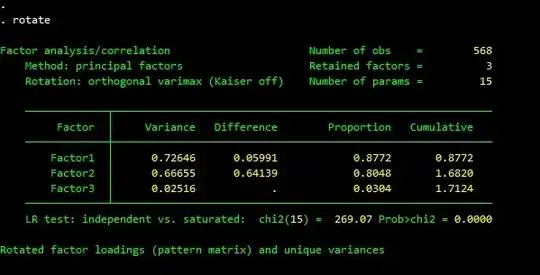I'm using Stata's exploratory factor analysis command ("factor"). When I ask for a rotated solution (using the varimax orthogonal method, which is the default) it gives me (aside from the loadings etc) a value called "proportion" for each factor (with the first factor having the highest value). Although Stata's documentation doesn't seem to ever say so explicitly I assume that "proportion" represents the proportion of the total variance in the observed variable explained by each latent factor. However, when I view a rotated solution the total "proportion" values often add up to more than 1, implying that the factors in total explain more than 100% of the variance in the observed variables, which seems nonsensical. This can be seen in Stata's example dataset for "factor"
If in stata you type:
"webuse bg2
factor bg2cost1 bg2cost2 bg2cost3 bg2cost4 bg2cost5 bg2cost6
rotate"
you will see that the "proportion" values for the 3 retained factors add up to 1.7124.
So what's going on here? Obviously I'm confused about what "proportion" means, but Stata's documentation doesn't seem to provide any guidance on how I should interpret this value. Also, how can I correctly characterize the explanatory power of rotated factors? I would like to be able to say that my first factor explains X% of the variance while the second factor explains Y%, but is that even possible with rotated solutions?
